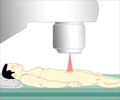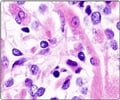The use of helium ions in radiation therapy could provide accurate treatment to tumors while helping healthy organs as per demonstration by the researchers for the first time.

"Particle beam therapy involving protons or carbon ions has advantages over conventional radiotherapy. Helium ions may represent another kind of particle that can improve radiotherapy treatment. Due to their increased mass, spreading of the beam is reduced by a factor of two as compared with protons. Moreover helium ions have an increased biological effectiveness at the end of their range," Mr Fuchs explains.
Heavier ions like carbon have the potential to kill cancer cells more effectively due to their underlying biology. But by modelling these biological processes, large uncertainties are introduced, and these can be reduced by using lighter ions like helium. "Helium ions reside in the low Linear Energy Transfer (LET) area," says Mr Fuchs. "LET is a physical quantity describing how much energy of a particle is deposited at a given range, and this measure is important when looking at the biological effects of therapy."
This greater accuracy and sparing of normal tissue is very important in the case of children, the researchers say. When treating them it is particularly important to ensure that as little dose of radiation as possible is deposited outside the area to be treated, since an increased area treated with a low dose can lead to the development of secondary cancers. Given that children have a potentially long lifespan ahead of them, this probability needs to be reduced as much as possible through the use of therapies that are targeted as accurately as possible to the tumour, while sparing the dose to surrounding areas, and especially to healthy organs particularly sensitive to radiation located nearby (the organs at risk).
"After three years of extensive research and validation efforts, we were able to produce a treatment planning algorithm that enabled us to investigate the possibilities for using helium ion therapy in children treated with low dose radiation. We would now like to investigate its potential in patients being treated with higher doses, for example, those with brain tumours. The good results that have been achieved so far warrant the verification of the model in order to investigate the real clinical potential of helium ions," Mr Fuchs will say. "In the long term, clinical trials of this therapy will be needed to substantiate the effects of our treatment planning model.
"Particle beam therapy has already advanced care and treatment options for cancer patients. We hope that the use of helium ions may help to bring about further improvements," he will conclude.
Advertisement
Advertisement














